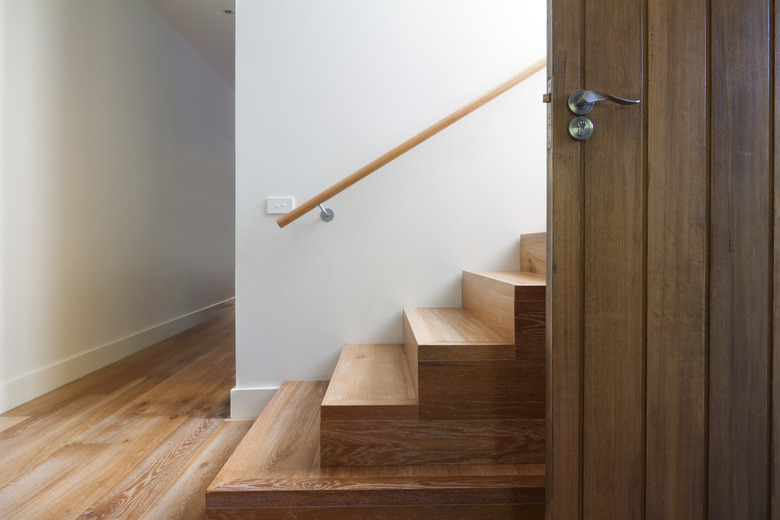How To Cut An Angle On A Handrail
We may receive a commission on purchases made from links.
Although you can cut stair rails with a circular saw if you have a steady hand and a good eye, the job is best done with a power miter saw, even if you're installing metal rails. Before you get to the actual cut, though, you have to determine the proper angle. That's fairly easy if you're installing a straight rail for a deck or basement staircase, but when you're installing more complex rails, you need a more reliable measuring device than a plumb bob. There are several tools on the market, such as a digital protractor, but you can make your own tool, called a pitch block, from a piece of plywood.
How To Make a Pitch Block
How To Make a Pitch Block
A pitch block is a right-angle triangle made from plywood with a hypotenuse sloped at the same angle as the stairs. To make one, lay the rail you're going to cut on the stairs and place a piece of plywood next to it so that one side is flat on a stair tread, and the other side is flush against the riser. Draw a line along the bottom of the rail and cut along that line to make a triangle.
This tool comes in especially handy for cutting decorative fittings for the tops and bottoms of handrails for interior staircases. Such fittings include volutes (spirals), turnouts, and easings. When using these fittings, the handrails themselves are cut at 90-degree angles, and you cut the fittings to the slope of the staircase. When done accurately, the fittings butt flush against the ends of the rails and are attached with rail bolts.
Measuring and Cutting a Railing Fitting
Measuring and Cutting a Railing Fitting
Set the railing fitting on a flat surface with the part that attaches to the railing extending upward and the termination of the fitting flat on the ground. Slide the pitch block underneath with the run side (the side that sat on the tread when you drew the line) flat against the surface and the rise side (the side that was against the riser) extending up. The fitting will contact the hypotenuse at one point, so mark the point on the fitting. Invert the pitch block so the rise side is on the ground, set it next to the fitting so the hypotenuse intersects the mark, and draw a line on the fitting along the hypotenuse. This is the cut line.
To cut the fitting, use the pitch block to support it on the miter saw table. Set the fitting so the cut line is perpendicular to the saw table and insert the pitch block with the run side flat on the table and the part of the fitting that rises flush against the hypotenuse. You don't need to adjust the saw angle. Put on a pair of goggles, clamp the fitting to the fence with a C-clamp so it doesn't move, and cut along the line.
A Simple Method for Straight Handrails
A Simple Method for Straight Handrails
You can mark the angle for a straight handrail for a deck or basement staircase with a plumb bob or 2-foot level. Set the handrail on the posts and mark the distance from the bottom post where the cut needs to be made (typically about 4 inches), leaving enough at the top to make a second cut. Either hang a plumb bob from that point or set a level on it and center the bubble. Draw the cut line along the string or the edge of the level.
Place the rail on the saw table and adjust the cutting angle of the blade to coincide with that of the cut line. Clamp the rail and cut along the line. Measure the length of the railing, make a mark for the top cut, and then use the offcut to draw the angle. Remember that the top angle must slope in the opposite direction of the one at the bottom.
